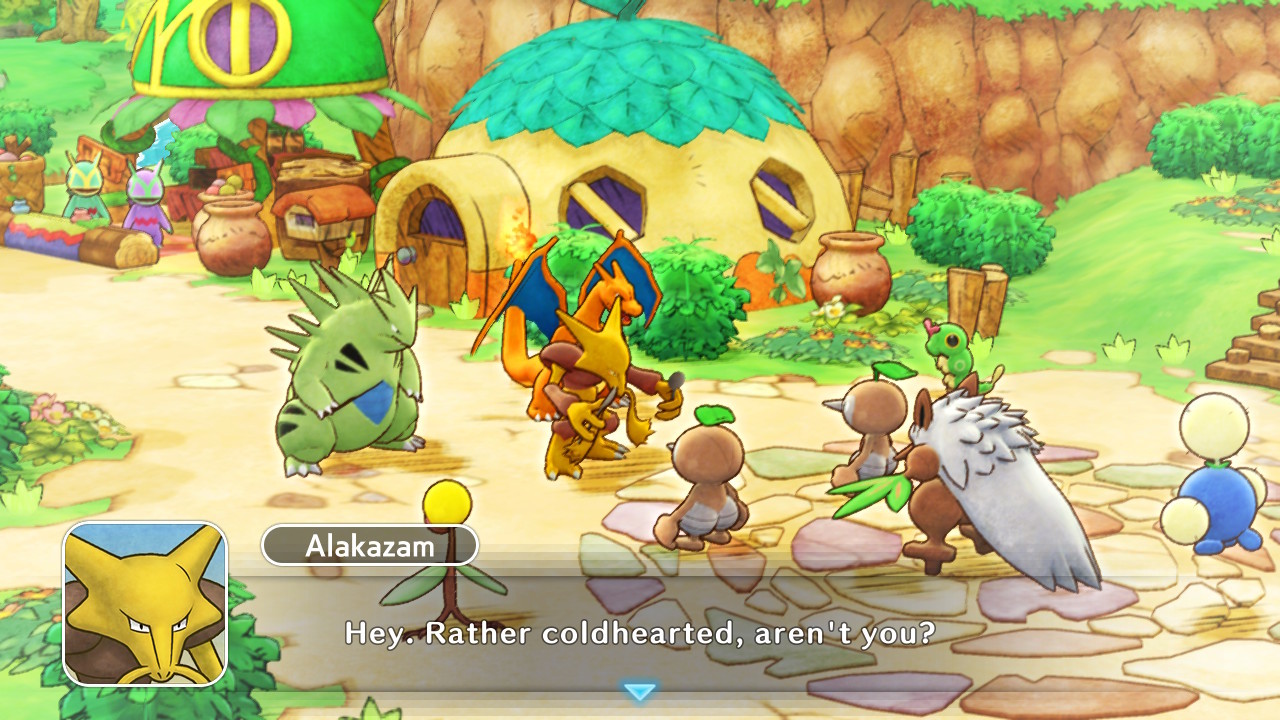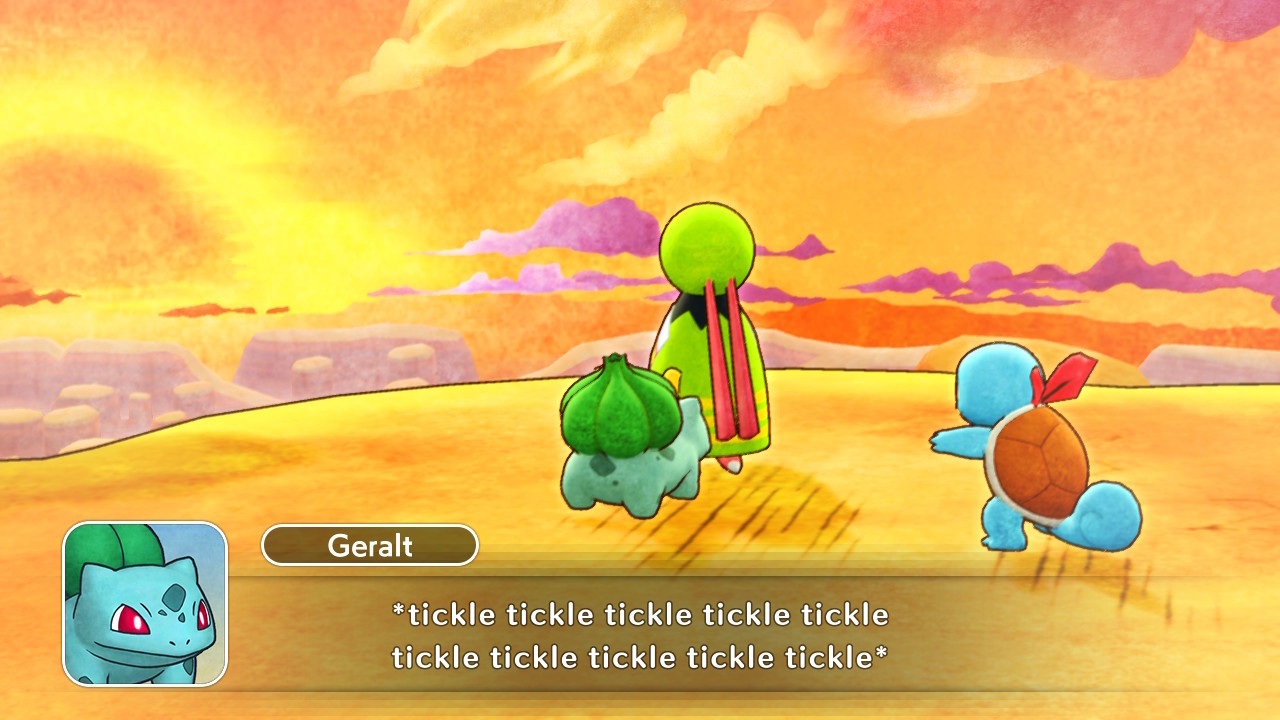When the original pair of Pokemon Mystery Dungeon games were released in 2006, they were received as the ugly Duckletts of Pokemon spin-offs. Now, almost 15 years later, it is clear how wrong we were to write off Spike Chunsoft's ambitious take on the titanic series: Pokemon Mystery Dungeon: Rescue Team DX for Switch is wondrous to play and, in a way, boasts a substantially more resonant fable than most other recent Pokemon games.
You wake up one morning and everything seems pretty ordinary, at least until you realize that you're not a human anymore. Instead, you've magically and mysteriously metamorphosed into a Pokemon--which exact species is determined by a fun little personality quiz you take at the beginning of the game. Before long you make a new best friend, who is also a Pokemon, and you decide to form a rescue team together. Why? To save foolish Pokemon who have ventured into dangerous dungeons stricken by environmental disasters, even though they're totally aware of said environmental disasters. Over the course of the game, you embark on arduous odysseys to the many dungeons scattered sporadically across the world of Pokemon, each of which contains several 'mons in desperate need of help and lots of others who are a bit aggravated by the daily earthquakes.

What's important about Mystery Dungeon carving itself out a new home on Switch is that DX isn't just some sort of lazy rehash. Perhaps the most striking thing about this reworked spin-off, at least at first, is its revised color palette. It's pretty different to the old Mystery Dungeon games, sporting a warm painterly style to replace the originals' GBA-era pixel art. The revamped rescue base you get about halfway through the game is especially gorgeous, while the relentlessly upbeat soundtrack is capable of both intensifying the charming tone of the art and flipping even the tensest moments on their head. This is an essential part of the game's overall appeal, as it goes hand in hand with the fact that Mystery Dungeon is ultimately about overcoming adversity with a smile on your face. One second it seems as if you're on the verge of the inevitable apocalypse, the next you're bobbing along, beaming for no reason, ready to hurtle headlong into a procedurally generated dungeon to save some 'mons and make some money.
As you might expect, dungeon-crawling is the game's core component. The stylish art design extends to the dungeons, which range from molten caverns buried deep beneath the earth's crust to airborne towers suspended high above the clouds. But on top of that, their mechanical design works well in moment-to-moment gameplay. Area traversal in dungeons is tile-based, which might seem a little rudimentary at first but complements Mystery Dungeon's combat system, the core building block for some of the game's most impressive elements.
Each Pokemon can learn up to four moves, just like in the mainline series. How these moves function is determined by the tile-based map layouts--for example, Water Pulse covers four tiles, whereas Aqua Tail can only connect with enemies who are directly adjacent to you. Moves like Brick Break don't work around corners, but ranged moves like Water Gun and Razor Leaf do--it's unclear whether they bend around them or simply go over them, but a lot of moves that would logically require your opponent to be within arm's length fail unless those conditions are met, which is just one fold to the overall strategy.
You've got to be extra careful with your battle tactics--the juxtaposition of tile-based movements with turn-based combat means that simply walking constitutes an entire turn. It's like a board game, where you can either move one space, use an item, or launch an attack. And, given that you can have between three and eight members on your squad at any given time, you're constantly monitoring turns and tiles for a variety of Pokemon simultaneously. It has the potential to be complex if you want it to be, but because you have multiple lives, it never gets so difficult that you'll find yourself stuck in a rut. As a result, combat is both intuitive and engrossing, and the tile-based component adds a nice bit of nuance to the familiar four-move, elemental effectiveness formula we've grown to know and love over the years.
There is one downside to combat, though: There are still no health bars in Mystery Dungeon. In general, most enemies in a given dungeon will have roughly the same health, so if you pay attention to how much damage you deal, it's pretty easy to estimate your opponents' HP and plan your moves and item use accordingly. Boss battles are a different beast--there is no way to know how much of their massive HP bar has been depleted. This results in a lot of expensive item wasting and moments where you go, "One more hit and Rayquaza's finished," after which Rayquaza takes a Thunderbolt on the chin and Hyper Beams you back to the last checkpoint.

You lose all your money and items when you faint, so it can be pretty annoying to repeat a boss fight with even fewer resources, but every major dungeon has a checkpoint just a couple of levels shy of the boss fight. What's more, it seems the boss' HP doesn't regenerate--when I went back into Rayquaza after it sent us packing, myself (Squirtle), Geralt (Bulbasaur), and Absol (Absol, he's too cool for nicknames) managed to take it down in just a few hits. The short boss runs and lack of health regeneration does, in a sense, make up for the lack of a health bar because it removes almost all elements of stress that could potentially stem from that.
There have been several other new quality-of-life improvements made to combat--for example, certain Pokemon now possess "rare qualities," which can really help you out while you're dungeon-crawling. Sales Pitch allows you to make extra money from the miserly Kecleon, who hunts for free items in dungeons and then sells them at stupidly inflated prices, whereas Squad Up means that the more Pokemon you currently have in your posse, the more likely defeated foes are to join the crew. Also--and this is particularly handy--simply pressing A automatically selects the best move to use against your opponent at any given time, which means you'll never have to spend too long trying to figure out the optimal move if you don't want to.
One of the things that was most heavily criticized about the original Mystery Dungeon was how long and repetitive dungeons were. They can still be a tad annoying at times in the remake, but they're substantially less time-consuming than before, and they genuinely feel as if they're worth exploring. On several occasions I was lucky enough to spawn directly next to the stairs to the following floor, but every single time I eschewed quick progression for a thorough exploration of my current surroundings. "Maybe I'll find a few Oran Berries that could come in handy during the boss fight," I would muse to myself. "Or perhaps an All Dodge Orb that will ensure Groudon's Lava Plume goes in the completely wrong direction."

The average dungeon-completion times complement the story's pacing. At the beginning, you can storm the likes of Tiny Woods and Thunderwave Cave in under four minutes--but by the time you reach the late game, you're talking 34 floors, most of which are affected by weather conditions like Hail or Sandstorm, and a grueling fight against a boss to top it all off. Naturally, this dungeon takes quite a bit longer, but that's to be expected--as you approach the endgame, things get tougher and, by extension, far more tense and gripping. It's also worth noting that the Pokemon you encounter in each dungeon seem to be substantially more varied than before, with fan favourites like Houndoom and Scyther appearing fairly early on. If there's anything capable of diluting the slight tedium of the original Mystery Dungeon, it's allowing you to recruit some of the cooler 'mons earlier.
The story itself is unchanged, but it's far better than I remember. I was concerned nostalgia would make or break my experience with Mystery Dungeon DX (I was 10 when I played the originals), but I was pleasantly surprised to find it has one of the most emotionally resonant Pokemon stories in years--and that's largely because the Pokemon are anthropomorphized. They have personalities, ambitions, quirks, and dreams. Tyranitar isn't just the monster you keep in your squad to unleash devastating Earthquakes, he's a goofy celebrity who makes terrible jokes and genuinely wishes the best for you. Charizard is a lovable idiot. Alakazam is the bee's knees, the cool kid on the block, the Pokemon who carries his spoons around with him even when he's just popping over to Pokemon Square to chat with his mates. And whomever you choose as your buddy Pokemon... let's just say I might have told my brother I had something in my eye when he came down to grab a glass of water at 2 AM. Giving Pokemon proper, three-dimensional personalities changes the lens you view them through for the better, and, as a result, playing through Mystery Dungeon will inevitably have a positive impact on how I relate to the Pokemon series as a whole.
Whether or not you're an old-school Mystery Dungeon aficionado or a total newcomer to the long-derelict spin-off series doesn't necessarily matter: Mystery Dungeon on Switch improves upon the originals with some valuable quality-of-life tweaks, making it a worthwhile play regardless of your familiarity with the series. It features a distinct combat system that provides an intriguing alternative to the mainline Pokemon formula with tile-based strategizing, humanizes the Pokemon you've fallen in love with over the years, tells a riveting and emotional story that will make you view the franchise in a totally different light, and does so with a stylish suite of visuals and music.
Eventually, every ugly Ducklett becomes a Swanna.









